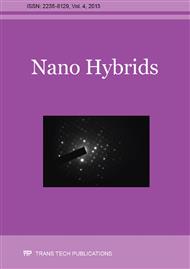[1]
A.H. Flood, J. F. Stoddart, D.W. Steuerman, J.R. Heath, Whence molecular electronics?, Science 306 (2004) 2055-2056.
DOI: 10.1126/science.1106195
Google Scholar
[2]
I.A. Campbell, Strong and weak ferromagnetism in Ni-Fe alloys, J. Phys. F: Met. Phys. 4 (1974), L181-L183.
DOI: 10.1088/0305-4608/4/8/003
Google Scholar
[3]
A. Kokalj, Computer graphics and graphical user interfaces as tools in simulations of matter at the atomic scale, Comp. Mater. Sci. 28 (2003) 155-168.
DOI: 10.1016/s0927-0256(03)00104-6
Google Scholar
[4]
D. Dulic, S.J. van der Molen, T. Kudernac, H.T. Jonkman, J.J.D. de Jong, T.N. Bowden, J. van Esch, B.L. Feringa, B.J. van Wees, One-way optoelectronic switching of photochromic molecules on gold, Phys. Rev. Lett. 91 (2003) 207402.
DOI: 10.1103/physrevlett.91.207402
Google Scholar
[5]
N. Katsonis, T. Kudernac, M. Walko, S.J. van der Molen, B.J. van Wees, B.L. Feringa, Reversible conductance switching of single diarylethenes on a gold surface, Adv. Mater. 18 (2006) 1397-1400.
DOI: 10.1002/adma.200600210
Google Scholar
[6]
K. Matsuda, H. Yamaguchi, T. Sakano, M. Ikeda, N. Tanifuji, M. Irie, Conductance Photoswitching of Diarylethene-Gold Nanoparticle Network Induced by Photochromic Reaction, J. Phys. Chem. C 112 (2008) 17005-17010.
DOI: 10.1021/jp807479g
Google Scholar
[7]
A.J. Kronemeijer, H.B. Akkerman, T. Kudernac, B.J. van Wees, B.L. Feringa, P.W. Blom, B. de Boer, Reversible conductance switching in molecular devices, Adv. Mater. 20 (2008) 1467-1473.
DOI: 10.1002/adma.200800053
Google Scholar
[8]
S.J. van der Molen, J. Liao, T. Kudernac, J.S. Agustsson, L. Bernard, M. Calame, B.J. van Wees, B.L. Feringa, C. Schöneberger, Light-Controlled Conductance Switching of Ordered Metal-Molecule-Metal Devices, Nano Lett. 9 (2009) 76-80.
DOI: 10.1021/nl802487j
Google Scholar
[9]
J. He, F. Chen, P.A. Liddell, J. Andreasson, S.D. Straight, D. Gust, T.A. Moore, A.L. Moore, J. Li, O.F. Sankey, S.M. Linday, Switching of a photochromic molecule on gold electrodes: single-molecule measurements, Nanotechnology 16 (2005) 695-702.
DOI: 10.1088/0957-4484/16/6/012
Google Scholar
[10]
E.S. Tam, J.J. Parks, W.W. Shum, Y.W. Zhong, M.B. Santiago-Berríos, X. Zheng, W. Yang, G.K.L. Chan, H.D. Abruña, D. Ralph, Single-Molecule Conductance of Pyridine-Terminated Dithienylethene Switch Molecules, ACS Nano 5 (2011) 5115-5123.
DOI: 10.1021/nn201199b
Google Scholar
[11]
J. Li, G. Speyer, O.F. Sankey, Conduction switching of photochromic molecules, Phys. Rev. Lett. 93 (2004) 248302.
DOI: 10.1103/physrevlett.93.248302
Google Scholar
[12]
M. Zhuang, M. Ernzerhof, Mechanism of a molecular electronic photoswitch, Phys. Rev. B 72 (2005) 073104.
Google Scholar
[13]
M. Kondo, T. Tada, K.A. Yoshizawa, A theoretical measurement of the quantum transport through an optical molecular switch, Chem. Phys. Lett. 412 (2005) 55-59.
DOI: 10.1016/j.cplett.2005.05.126
Google Scholar
[14]
Y. Tsuji, A. Staykov, K. Yoshizawa, Orbital view concept applied on photoswitching systems, Thin Solid Films 518 (2009) 444-447.
DOI: 10.1016/j.tsf.2009.07.037
Google Scholar
[15]
M. Volmer, M. Stratmann, H. Viefhaus, Electrochemical and electron spectroscopic investigations of iron surfaces modified with thiols, Surface and Interface Analysis 16 (1990) 278-282.
DOI: 10.1002/sia.740160158
Google Scholar
[16]
A. Odell, A. Delin, B. Johansson, I. Rungger, S. Sanvito, Investigation of the Conducting Properties of a Photoswitching Dithienylethene Molecule, ACS Nano 4 (2010) 2635-2642.
DOI: 10.1021/nn100217r
Google Scholar
[17]
A. Odell, A. Delin, B. Johansson, K. Ulman, S. Narasimhan, I. Rungger, S. Sanvito, Comparison between s- and d-electron mediated transport in a photoswitching dithienylethene molecule using ab initio transport methods, Phys. Rev. B 84 (2011) 165402.
DOI: 10.1103/physrevb.84.165402
Google Scholar
[18]
J.M. Soler, E. Artacho, J.D. Gale, A. Garcia, J. Junquera, P. Ordejon, D. Sanchez-Portal, The SIESTA method for ab initio order-N materials simulation , J. Phys.: Cond. Matt. 14 (2002) 2745-2779.
DOI: 10.1088/0953-8984/14/11/302
Google Scholar
[19]
A.R. Rocha, V. Garcia-Suarez, S.W. Bailey, C.J. Lambert, J. Ferrer, S. Sanvito, Towards molecular spintronics , Nature Materials 4 (2005) 335-339.
DOI: 10.1038/nmat1349
Google Scholar
[20]
A.R. Rocha, V. Garcia-Suarez, S.W. Bailey, C.J. Lambert, J. Ferrer, S. Sanvito, Spin and molecular electronics in atomically generated orbital landscapes, Phys. Rev. B. 73 (2006) 085414.
DOI: 10.1103/physrevb.73.085414
Google Scholar
[21]
I. Rungger I, S. Sanvito, Algorithm for the construction of self-energies for electronic transport calculations based on singularity elimination and singular value decomposition, Phys. Rev. B. 78 (2008) 035407.
DOI: 10.1103/physrevb.78.035407
Google Scholar
[22]
C. Toher, A. Filippetti, S. Sanvito, K. Burke, Self-interaction errors in density-functional calculations of electronic transport, Phys. Rev. Lett. 95 (2005) 146402.
DOI: 10.1103/physrevlett.95.146402
Google Scholar
[23]
N. Troullier, J.L. Martins, Efficient pseudopotentials for plane-wave calculations, Phys. Rev. B 43 (1991) 1993-2006.
DOI: 10.1103/physrevb.43.1993
Google Scholar
[24]
J.P. Perdew, K. Burke, and M. Ernzerhof, Generalized gradient approximation made simple, Phys. Rev. Lett. 77 (1996) 3865-3868.
DOI: 10.1103/physrevlett.77.3865
Google Scholar
[25]
M. Büttiker, Y. Imry, R. Landauer, S. Pinhas, Generalized many-channel conductance formula with application to small rings, Phys. Rev. B 31 (1995) 6207-6215.
DOI: 10.1103/physrevb.31.6207
Google Scholar
[26]
I. Rungger, O. Mryasov, S. Sanvito, Resonant electronic states and I-V curves of Fe/MgO/Fe(100) tunnel junctions, Phys. Rev. B 79 (2009) 094414.
DOI: 10.1103/physrevb.79.094414
Google Scholar
[27]
S. Datta, Electrical resistance: an atomistic view, Nanotechnology 15 (2004) S433-S451.
DOI: 10.1088/0957-4484/15/7/051
Google Scholar
[28]
C.D. Pemmaraju, I. Rungger, S. Sanvito, Ab initio calculation of the bias-dependent transport properties of Mn-12 molecules, Phys. Rev. B 80 (2009) 104422.
DOI: 10.1103/physrevb.80.104422
Google Scholar


